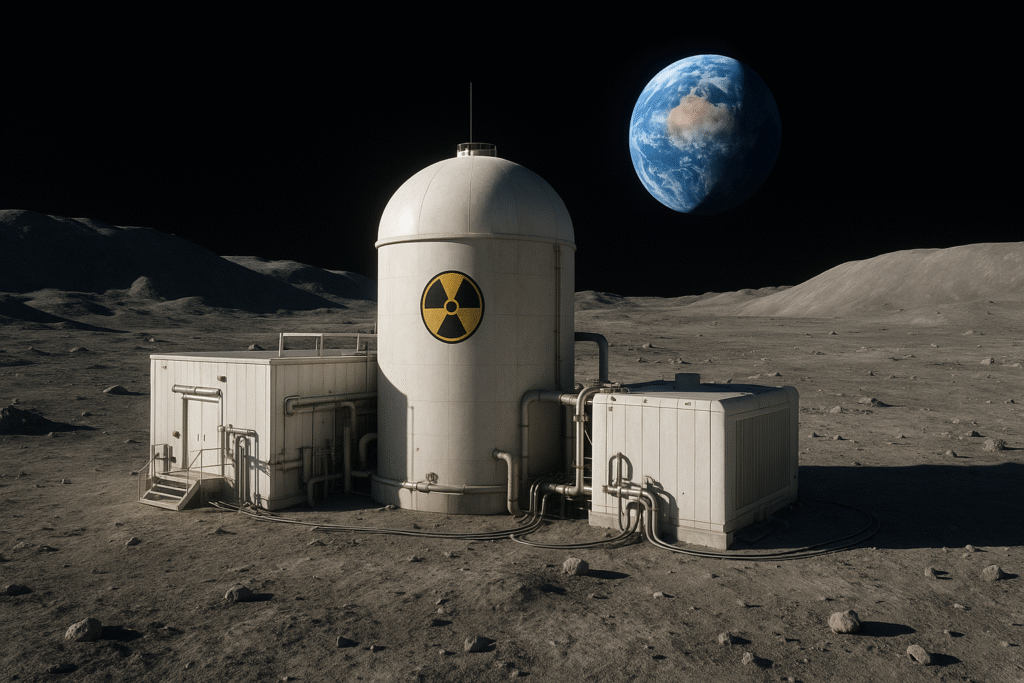
The idea of placing a nuclear reactor on the moon no longer seems like science fiction. NASA’s plan is going well; by 2030, it aims to create 100 kW lunar nuclear reactors, with the target for a continuous human presence on the moon as part of the Artemis programme—and eventually, Mars. This step indicates a bold shift towards reliable, round-the-clock power that a solar panel alone cannot provide.
Why is an Atomic Reactor Required on the Moon?
First and most important, the lunar environment challenges every traditional power source. A single lunar night extends to about 14 Earth days, which makes solar panels incredible for long-term missions. Therefore, a fragrance surface power system provides independent, continuous energy independent of sunlight. Unlike radioisotope generators – which provide limited strength – small nuclear reactors can continuously distribute tens of kilowatts.
In addition, the Moon’s south poles are such remote areas – where water ice and helium-3 resource deposits are probably present – in permanently shaded craters with sunlight for a few weeks. A buried nuclear reactor can brighten these areas and support life. Support system, rovers, research lab, and mining prototypes.
NASA’s Fragmentation Surface Power Project
NASA and the US Department of Energy (DOE) launched the fragmentation surface power project in 2020. By 2022, he awarded Lockheed Martin, Westinghouse, and joint venture X ‘energy/sahaja knowledge-rich machines with an early $5 million.
Each team developed a concept for a compact 40 kW reactor under six metric tonnes, capable of operating autonomously for ten years, which is buried below the lunar regolith with the radiator for heat rejection.
These designs were deliberately flexible, encouraging innovation while completing baseline glasses: continuous 40 kW power generation – about 30-33 Earth houses to strengthen – and a form factor suitable for rocket delivery.
Phase 2 of the task is slated for 2025, with a plan to finalise and take a look at full designs, aiming to provide a flight-equipped system inside the early 2030s.
New Instructions: Scaling Up To 100 kW
Recently, acting NASA Administrator Sean Dafi issued updated instructions to the 100KW lunar reactor by 2030 to rapidly track. This acceleration stems from geopolitical urgency: if rivals like America delay, China and Russia can manufacture their reactors, claiming “Own Owt Zone” under Artemis. A large reactor supports widespread operations such as habitat modules, lunar industrial activity, and deep exploration goals.
As a result, NASA plans to resolve the proposals within 60 days and appoint a project leader immediately. Companies with proven abilities, such as BWX Technologies – whose stock has recently increased on related news – are already in the spotlight.
How to Work a Lunar Atomic Reactor
Technically, the reactor makes NASA’s Kilopavar/Crusty experiments, such as heritage systems. Crusty Prototype displayed that a compact uranium-235 reactor’s core, heat, pipes, and sterling engines can safely turn nuclear heat into power in vacuum conditions.
Thus, the lunar reactor will possibly use the preservation of low ED-rich uranium, passive cooling through radiators, strong autonomous control systems, and core undergraduates. With minimal human participation, reactors can maintain power generation while avoiding harmful radiation risk.
Benefits: Enabling Permanent Lunar Missions
An atomic reactor on the moon opens many possibilities:
- Continuous power during long lunar nights.
- Support for Habitat Life Support, Rover Operations, and Scientific Laboratories.
- Powering the SITU Resource Use (ISRU) system to remove water, oxygen, fuel, and other materials.
- Enabling lighting and processing in permanently shaded areas for exploration.
- Laying the groundwork for the deployment of a future reactor on Mars using Siddha Lunar technology.
Challenges and Security Ideas
NASA faces significant engineering and regulatory challenges. Launching nuclear material from Earth demands extraordinary safety protocols. The reactor should launch stress, safely avoid land, and work firmly into the rigid lunar environment. Additionally, the preservation should reduce radiation for both astronauts and sensitive equipment.
Environmental ethics and space treaties also come in sports, as the Outer Space Treaty restricts regional claims. Americans want to avoid controversies – with strategic “security sectors” potentially explained as the American jurisdiction in lunar regions.
Global Competition: China, Russia, and Associates
While NASA is carrying on efforts, rival nations are not useless. China and Russia’s International Lunar Research Station (ILRS) – A are collaborating on a joint moon base, which may include its nuclear power system by the mid-2030s. A first reactor may allow them to define the restricted areas before coming to the US.
Similarly, companies such as other partners, including the UK Space Agency and Rolls, are funding modular reactors for future space use.
What Lies Ahead
In summary, atomic reactors on the moon are designed to become the foundation stone of off-range exploration. NASA’s fragmentation surface power project is developing rapidly—from 40 kW designs towards a more powerful and strategic 100 kW reactor prepared by 2030. Geophysical competition and technical urgency, with the goals of deployment, can provide reliable, safe, and constant strength for lunar atomic reactors for permanent lunar operation.
Due to the technology maturing, the concept can be up to Mars and beyond. Nevertheless, the journey includes complex engineering, security, and diplomatic navigation. If successful, atomic power on the moon will convert human appearance into another world—and mark a new chapter in space exploration.

